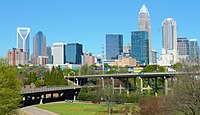
Photo from wikipedia
Increasing energy efficiency of the housing stock is one of the largest challenges in the built environment today. In line with the international Paris-Climate-Change-Conference 2015, Dutch municipalities and housing associations… Click to show full abstract
Increasing energy efficiency of the housing stock is one of the largest challenges in the built environment today. In line with the international Paris-Climate-Change-Conference 2015, Dutch municipalities and housing associations have embraced the ambition to achieve carbon neutrality for their social housing stock by 2050. However, most deep renovation designs for increasing the energy efficiency of dwellings focus on the relatively easy portion of the housing stock: postwar row housing. Furthermore, such design solutions are mostly produced without much care for architectural quality and cultural heritage, nor for testing for consumer preferences. Yet, such aspects are of major importance in tenement housing, particularly regarding the architectural quality of the huge numbers of walk-up apartment buildings from the inter- and postwar periods owned by housing associations in the larger cities. Renovation of buildings of this typology is more complex because of, among others, technical, social, and heritage factors. To support decisions in this complex context, a General Transformation Framework and a Roadmap has been developed for generating design solutions for deep renovation of representative parts of postwar walk-up apartment buildings with the aim to increase energy efficiency; retain its architectural legibility and cultural heritage value; and allow for the presentation of (end) users, with various options for adaptation to assess their preferences.
Journal Title: Sustainability
Year Published: 2018
Link to full text (if available)
Share on Social Media: Sign Up to like & get
recommendations!